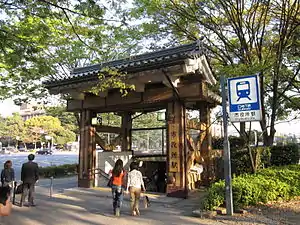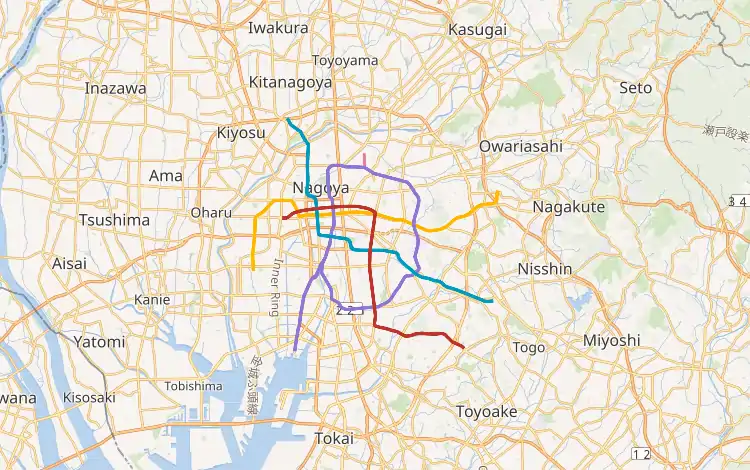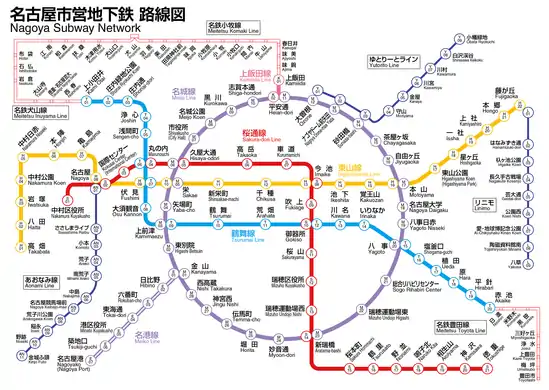Nagoya Municipal Subway
The Nagoya Municipal Subway (名古屋市営地下鉄, Nagoya Shiei Chikatetsu) is a rapid transit system serving Nagoya, the capital of Aichi Prefecture in Japan. It consists of six lines that cover 93.3 kilometers (58.0 mi) of route and serve 87 stations.[1] Approximately 90% of the subway's total track length is underground.
 Nagoya Municipal Subway Logo | |||
| Overview | |||
|---|---|---|---|
| Native name | 名古屋市営地下鉄 Nagoya Shiei Chikatetsu | ||
| Locale | Nagoya, Aichi, Japan | ||
| Transit type | Rapid Transit | ||
| Number of lines | 6 | ||
| Number of stations | 87[1] | ||
| Daily ridership | 1,171,289[2] | ||
| Website | Transportation Bureau, City of Nagoya | ||
| Operation | |||
| Began operation | 15 November 1957 | ||
| Operator(s) | Transportation Bureau City of Nagoya | ||
| Technical | |||
| System length | 93.3 km (58.0 mi)[1] | ||
| Track gauge | 1,435 mm (4 ft 8 1⁄2 in) (Higashiyama and Meijō/Meikō Lines) 1,067 mm (3 ft 6 in) (Tsurumai, Sakura-dōri, and Kamiiida Lines) | ||
| Electrification | 600 V DC third rail (Higashiyama and Meijō/Meikō Lines) 1,500 V DC overhead lines (Tsurumai, Sakura-dōri, and Kamiiida Lines) | ||
| |||
The subway system is owned and operated by Transportation Bureau City of Nagoya and, like other large Japanese cities including Tokyo and Osaka, is heavily complemented by suburban rail, together forming an extensive network of 47 lines in and around Greater Nagoya. Of them, the subway lines represent 38% of Greater Nagoya's total rail ridership of 3 million passengers a day.[3]
In 2002, the system introduced Hatchii as its official mascot.
Lines and infrastructure
The six lines that comprise the Nagoya subway network are, for the most part, independent. However, Meikō Line services partially interline with the Meijō Line, and the operations of both lines are combined. Therefore, there are in fact five distinct services on the subway. They are mostly self-contained, but two of its lines have through services onto lines owned and operated by Meitetsu, the largest private railway operator in the region. One of these, the Kamiida Line, is essentially an extension of the Meitetsu Komaki Line to which it connects.
The first two subway lines, the Higashiyama and Meijō/Meikō Lines, run on standard gauge track and use 600 volt DC electrification from a third rail. They are three of the eleven subway lines in Japan which use both third-rail electrification and standard gauge track (the Ginza and Marunouchi lines in Tokyo are the only other two lines to use third rail at that voltage; five of the eight lines of the Osaka Metro and the Blue Line in Yokohama all use 750 V DC third rail). Subsequent lines were built to narrow gauge and employ 1,500 volt DC electrification from overhead lines, in common with most other rapid transit lines in the country.
As with other railway lines in Japan, tickets can be purchased from ticket vending machines in stations. Since February 2011, this has largely been supplemented by Manaca, a rechargeable smart card. By the next year, it had replaced Tranpass, the predecessor integrated ticketing system, which could be used at all subway stations and for other connected transportation systems in the region.[4]
| Line color |
Line icon |
Mark | Line number |
Name | Japanese | Opened | Last extension | Length | Stations |
|---|---|---|---|---|---|---|---|---|---|
| yellow | H | Line 1 | Higashiyama Line | 東山線 | 1957 | 1982 | 20.6 km (12.8 mi) | 22 | |
| purple | M | Line 2 | Meijō Line | 名城線 | 1965[Note 1] | 1971 | 8.9 km (5.5 mi) | 12[Note 2] | |
| Line 4 | 1974[Note 3] | 2004 | 17.5 km (10.9 mi) | 17[Note 2] | |||||
| purple | E | Line 2 | Meikō Line | 名港線 | 1971[Note 4] | – | 6.0 km (3.7 mi) | 7[Note 5] | |
| blue | IY | Via trackage rights | Meitetsu Inuyama Line | 名鉄犬山線 | 1993[Note 6] | – | 21.4 km (13.3 mi) | 13[Note 7] | |
| T | Line 3 | Tsurumai Line | 鶴舞線 | 1977 | 1993 | 20.4 km (12.7 mi) | 20 | ||
| TT | Via trackage rights | Meitetsu Toyota Line | 名鉄豊田線 | 1979[Note 8] | – | 15.2 km (9.4 mi) | 8[Note 9] | ||
| MY | Meitetsu Mikawa Line | 名鉄三河線 | N/A[Note 10] | – | 1.4 km (0.87 mi) | 2[Note 9] | |||
| red | S | Line 6 | Sakura-dōri Line | 桜通線 | 1989 | 2011 | 19.1 km (11.9 mi) | 21 | |
| pink | KM | Via trackage rights | Meitetsu Komaki Line | 名鉄小牧線 | 2003[Note 11] | – | 18.3 km (11.4 mi) | 13[Note 12] | |
| 2003[Note 13] | – | 2.3 km (1.4 mi) | 2[Note 14] | ||||||
| K | Line 7 | Kamiiida Line | 上飯田線 | 2003[Note 15] | – | 0.8 km (0.50 mi) | 2[Note 16] | ||
| Total (Subway only – not incl. trackage rights portions): | 93.3 km[1] | 87[1] | |||||||
Notes
- Between Ōzone Station, Sakae Station and Kanayama Station (Aichi)
- Including Ōzone Station
- Between Ōzone Station, Nagoya Daigaku Station and Kanayama Station (Aichi)
- Between Kanayama Station (Aichi) and Nagoyako Station
- Including Kanayama Station (Aichi)
- Between Inuyama Station and Kamiotai Station
- Including Kamiotai Station
- Between Akaike Station and Umetsubo Station
- Including Akaike Station
- Between Umetsubo Station and Toyotashi Station
- Between Inuyama Station and Ajima Station
- Including Ajima Station
- Owned by Kamiiida Link Line between Ajima Station and Kamiiida Station
- Including Ajima Station and Kamiiida Station
- Owned by Kamiiida Link Line between Kamiiida Station and Heian-dori Station
- Including Kamiiida Station
.jpg.webp)

.jpg.webp)
.JPG.webp)
Connecting services
JR Central
- (for Shin-Yokohama, Tokyo, Kyoto, and Shin-Osaka)
- Tōkaidō Main Line: at Nagoya and Kanayama
- (for Gifu, Ōgaki, Obu, Kariya, Okazaki, Toyohashi, and Hamamatsu)
- Chūō Main Line: at Nagoya, Kanayama, Tsurumai, Chikusa, and Ōzone
- (for Kozoji (transfer to former Expo Site), Tajimi, and Nakatsugawa)
- Kansai Main Line: at Nagoya and Hatta
- (for Yokkaichi, Tsu and Kameyama)
- Takayama Main Line: at Nagoya
- (Limited Express only, for Gero and Takayama)
Meitetsu
- Meitetsu Nagoya Line: at Nagoya and Kanayama
- (for Meitetsu Gifu, Chiryu, Hekinan, Nishio, Higashi Okazaki, Toyohashi, and Toyokawa Inari)
- Meitetsu Tokoname Line: at Nagoya and Kanayama
- (for Otagawa, Chita Handa, Kowa, Utsumi, Tokoname, and Central Japan Int'l Airport)
- Meitetsu Inuyama Line: at Nagoya, Kanayama, and Kami-Otai
- (for Iwakura, Inuyama, Mikakino and Shin Kani)
- Meitetsu Tsushima Line: at Nagoya and Kanayama
- (for Tsushima, Saya and Yatomi)
- Meitetsu Seto Line: at Sakae and Ōzone
- (for Owari Seto)
- Meitetsu Toyota Line: at Akaike
- (for Toyotashi)
Kintetsu
- Kintetsu Nagoya Line: at Nagoya and Hatta
- (for Yokkaichi, Tsu, Nakagawa, Matsusaka, Ise, Toba, and Osaka)
Nagoya Seaside Rapid Railway
- Aonami Line: at Nagoya
- (for Kinjo-Futo (Nagoya International Exhibition Hall))
Network Map

See also
References
- トップページ - ご意見・お問い合わせ - よくあるご質問 - 地下鉄について [Top - Feedback and inquiries - Frequently Asked Questions - For subway] (in Japanese). Transportation Bureau, City of Nagoya. Archived from the original on 14 July 2014. Retrieved 11 June 2014.
- 平成21年版名古屋市統計年鑑 11.運輸・通信 [Nagoya Statistics for Year 21 of the Heisei Era, 11 Transportation and Communication] (in Japanese). Nagoya City. 2009. Archived from the original on 16 June 2011. Retrieved 1 December 2010.
- "Archived copy" (PDF). Archived (PDF) from the original on 2017-03-29. Retrieved 2017-08-12.CS1 maint: archived copy as title (link)
- "Tickets - Nagoya Transportation Bureau". Archived from the original on 2014-03-11.
External links
| Wikimedia Commons has media related to Nagoya Municipal Subway. |
